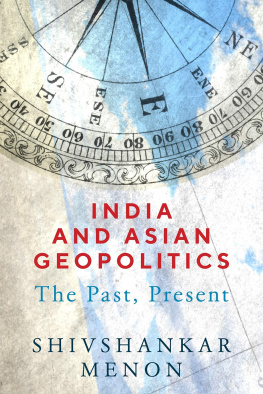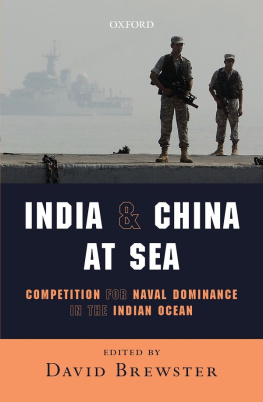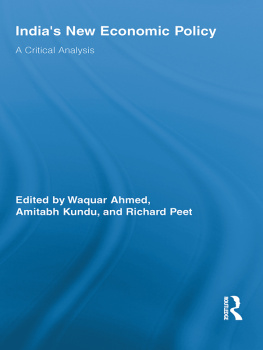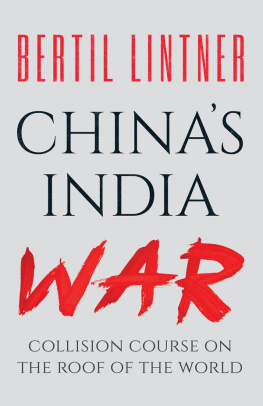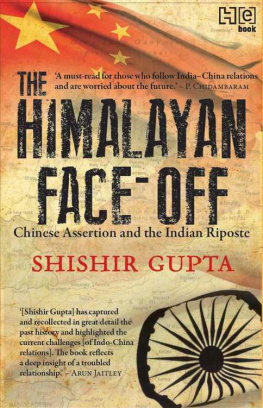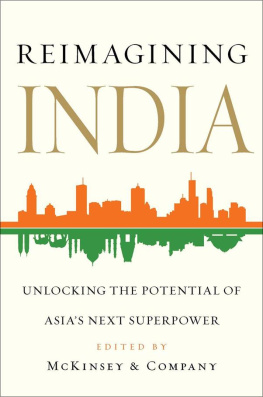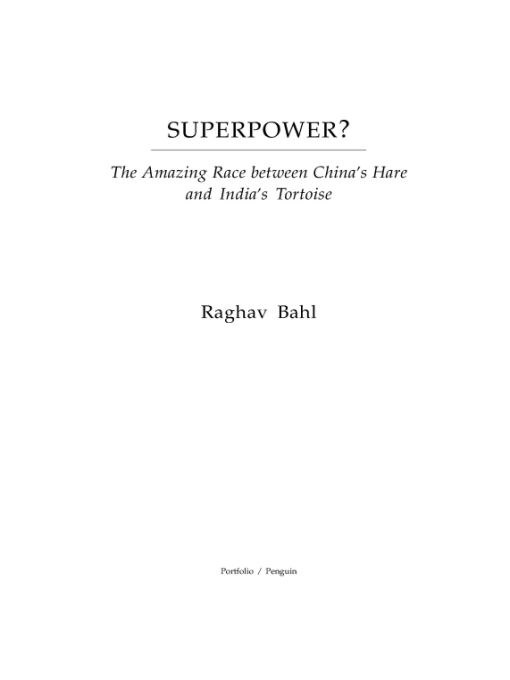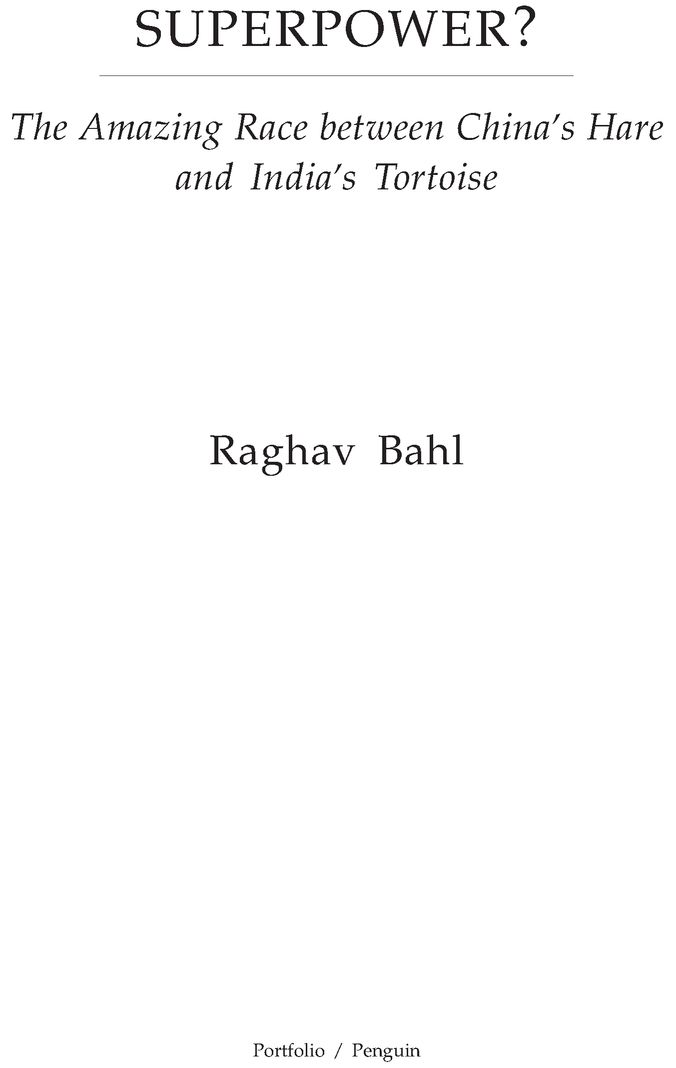Table of Contents
Dedicated to my late grandparents and my late father
for teaching me the virtues of ambition and excellence and to my mother
for being an embodiment of resilience
ACKNOWLEDGEMENTS
I owe a debt of gratitude to several people who have contributed their invaluable time and effort to make this book possible. Without question the biggest one is due to my colleague, Vivian Fernandes, who was my Executive Editor on this project. Vivian was a friend, philosopher, guide, researcher and critic through the effortwithout him, this work would not have come to fruition. Vivian is an outstanding journalist with a painstaking devotion to detail and excellence; his contribution is particularly compelling in chapters 4 and 5. I also owe a lot to my research associate, Renu Sharma, for her dogged and intelligent pursuit of facts and nuggets. I am also grateful to the professional and focussed team of young economists at AssignmentBuddy, led by Nishant Mehra and ably supported by Vidhi Pant. I simply cannot forget the intellectual energy that Shalini Iyer brought to her legal research on the two countries. I am also hugely thankful to Shagun Khare (entrepreneurship), Teshu Singh and Cheryl Jacob (colonial history) for assisting me with specific areas. Raja Rajeshwari, my redoubtable colleague at CNBC-TV18, was the last port of call on all bits and pieces of information. Finally, I thank my publishers Penguin India and my editor Udayan Mitra for taking a bet on a first-time author. I hope I have not let anybody downwhile the credit for this work belongs to everyone whos helped out, the errors and weaknesses are entirely mine.
I would like to end by acknowledging the moral and material support I have received from several colleagues and family members. Deepti Jain, my assistant, was indefatigable about searching Google, keying in data and taking printouts. Rajneesh Singh (Head of HR at Network18) and Saurabh Khandelwal (his assistant) were unstinting in their efforts to put together a research team; Ajit Andhare tracked potential publishers, Kshipra Jatana helped out with legal contracts and Piyush Jain managed the post-manuscript phase; Indrajit Gupta led the Forbes India team in designing the jacket; frankly, without all of them it would have been a no-go.
Last, and certainly not the least, I am deeply grateful to my family. My sister Vandana has always been around to see me through stressful times; my wife Ritu, daughter Tara and son Vidur were, as usual, pillars of strength. Ritu was there to egg me on whenever I got afflicted by doubt, and the kids happily adjusted their dinner time to accommodate my nocturnal stints in the study. Ultimately, their infectious smiles got me to the end.
I hope this book adds at least a sliver to your understanding of our world. I would then consider it a worthwhile effort.
Preface
WHY DONT THEY GET INDIA?
A lot of Indians believe in rebirth and transmigration of the soul. While it is an intellectually rich philosophy, its quick and everyday version simply means that a persons second, third, fourth or nth life is influenced by his actions, or karma, in previous ones. By this simplistic yardstick, I must have been a foreign investor in at least a couple of my earlier births!
Ever since I began my entrepreneurial life in the early 1990s, I have dealt, rather pleasantly, with foreign investors of all hues, shapes and sizes. One foreign investor or the other sits atop every key milestone. In the early days, there were venture capitalists just coming to grips with the maddening complexities of India. I was, in their lingo, a person with promising intellectual capital in a virgin consumer-focused business which was likely to witness explosive growth as Indias GDP shifted gears and consumer aspirations stretched beyond the needs of daily survival. In other words, I was a poor but bright fellow, bereft of any financial capital, brimming with special media skills and ideas, capable of creating value as the countrys television content business was unleashed. So if they gave me $5 million in cash and a chunk in equity, I could build a team of professionals and a company which could become a leader in Indias nascent media industry. Thats the first kind of foreign investor I encountered way back in 1993.
I must hand it to these guys for getting it somewhat right. Frankly, if I had $5 million in those days, I would have kept it under the mattress, but never given it away to a struggling thirty-two-year-old who barely had enough money to buy a second-hand car. But these guys did bet on us, and I daresay, made plenty of money. As our operations grew, we took bigger betsand ran into even weightier foreign investors! The early-stage venture capitalist gave way to the late-stage private equity chap, who now gave us $20 million, but took a smaller chunk of equity, simply because start-up risks had been mitigated, and proof of concept was visible in our growing operations. These fellows would visit us once every quarter, sit through board meetings, see some fancy graphics, meet our key people, tour the facilities, and round off with plenty of spirits at the Dublin bar. Their excitement about India was always subdued, tinged with an edge of scepticism, if not outright disbelief. Why does your government take so long to give approvals? Why is your foreign investment policy so restrictive? Why are your airports in such a shambles? How come your hotels are so good, when the roads leading to them are so potholed? How do you speak such good English? Why do you have so many newspapers? Why are so many of them in English? How are they able to survive? Why dont you lower your voice when you make fun of your politicians? How come your licence was not cancelled after you did such a tough interview with the finance minister? Why are there no malls here? Why are your cinema halls so rundown? Why dont Indian consumers pay for services?
Every conversation would end with some variant of the same observation: You know what, its not like that in Chinaor Korea, or Thailand, or Dubai.
As we acquired commercial muscle, our confidence and market share soared. From foreign investors who gave us equity capital, we moved up the value chain to do deals with foreign strategic playerslarge American media groups who bet their brand, programming and reputations with us. Our first joint venture was with CNBC to launch a twenty-four-hour business news channel in India. We made all the investments, took all the risks, and paid them a royalty. We followed through with another deal with CNN, to launch a twenty-four-hour general news channel in India. Again, we made all the investments, took all the risks and paid them a royalty. We then bought 50 per cent of Viacoms India operations, including such iconic brands as MTV India, Nickelodeon India and VH1 India. We put in slightly over $100 million to launch Colors, a general entertainment channel; the venture was led by our CEO, delighting our foreign partners with its spectacular success. Next on our rollcall was Forbes, as we set about publishing Forbes India.
In less than five years, we had put together a pantheon of the worlds leading media brands on the same Indian balance sheet. Who would have imagined, or dared, to bring such competing American media groupsCNBC, CNN, MTV, Nickelodeon, VH1, Forbesunder a single owner? I am often asked: How did you pull that off? My answer is a shrug; how do I say that I must have been a foreign investor in at least a couple of my previous births?





